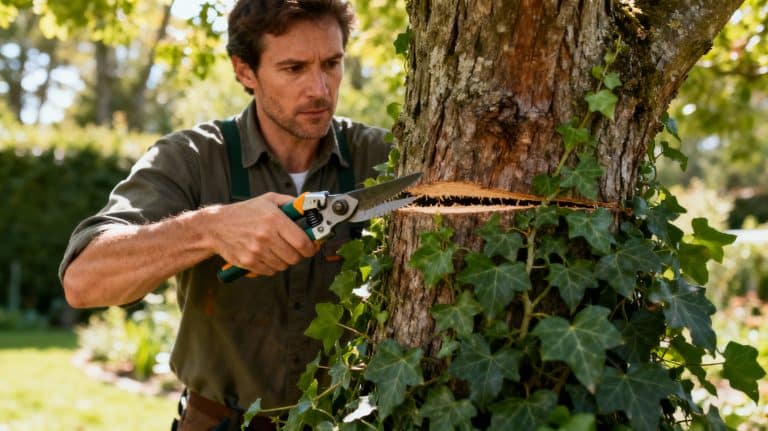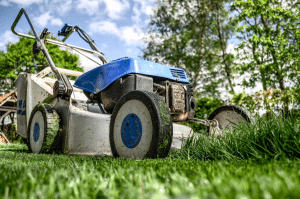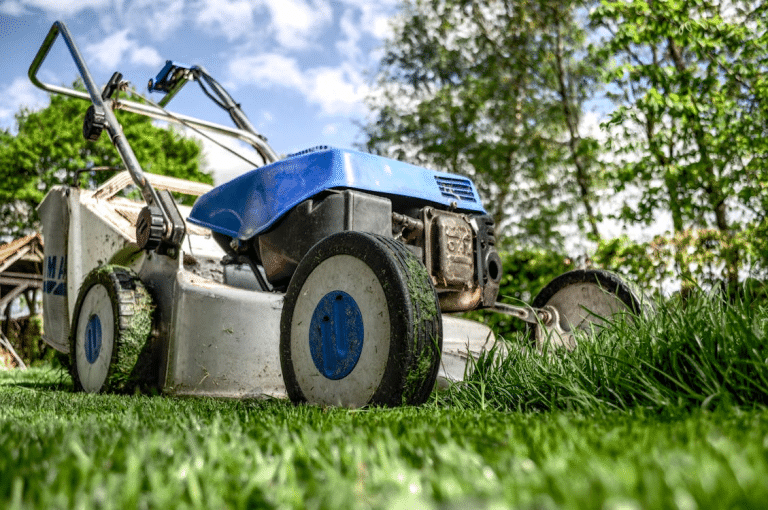In the garden, patience works. You can kill ivy vines for good. This isn’t about brute force, it’s about doing the right steps in the right order, so regrowth doesn’t stand a chance.
If you need a quick win right now, grab loppers and cut a 12-18 inch gap at the base of every ivy stem that’s climbing a tree, wall, or fence. Don’t yank what’s attached. Let it die in place first. You tug, it snaps wetly, and those tiny hairy rootlets stay glued to the brick.
Identification of Ivy and Safety Measures to Take
-
English ivy: evergreen leaves, sometimes lobed, vines with little “hairy” rootlets sticking to surfaces.
-
Poison ivy: “leaves of three.” If there’s any chance it’s poison ivy, wear gloves, long sleeves, and wash up with cold water after.
-
Trees: never rip attached vines off bark. Cut them at the base and let the upper growth dry and loosen over a few months.
The Right Way to Cut Poison Ivy
First Move: Cut a 12–18 Inch Kill Ring at the Base
Fast relief starts with starving the upper vines. Here’s the sequence that works.
-
Expose the base. Pull back mulch and leaf litter so you can see each vine where it hits soil.
-
Cut two parallel slices 12-18 inches apart on every stem at ground level. Remove that middle section. This creates a dead zone so the top can’t re-root.
-
On ground mats, slice the ivy into 2-3 foot “tiles” with a flat spade so it can’t pull tension across the whole bed.
What you’ll notice: within 24-48 hours, the leaves above your cuts lose that glossy look and start to dull. On vertical surfaces, they’ll begin to dry and turn brittle over the next few weeks, making later cleanup easy.
Second Move: Cut Stump Treatment to Stop Regrowth
The kill ring stops the top. Now you prevent the root crowns from re-sprouting forever.
The most reliable method is cut stump treatment. Right after you make each cut (think within five minutes), paint the fresh stump surface with a brush killer concentrate per label directions or use the baggie method for vines. Two active ingredients work well on ivy:
-
Triclopyr (often sold as “brush killer”): excellent on woody vines.
-
Glyphosate (41%+ concentrate): also effective when applied to fresh cuts.
Use a small foam brush or a squeeze bottle with a dauber cap so you only touch the cut surface, especially the outer ring where the cambium is. This bypasses ivy’s waxy leaves and takes the kill straight to the roots with minimal chemical.
If you prefer to avoid herbicides, skip down to solarization. You’ll trade speed for certainty over a longer window.
You’ll know it’s working when shoots near those treated stumps stop pushing new leaves within 5-7 days. By 10-14 days, the cut crowns brown and feel dry instead of springy.
Keep kids and pets off treated areas until dry. Choose a calm, rain-free day, and follow the label always for Roundup and dog safety.
Why Ivy Keeps Coming Back: Energy in Root Crowns
Ivy is a battery with leaves. It banks energy in tough, woody crowns and horizontal roots a few inches under the soil. When you tear off the top, the battery simply powers new shoots.
Sprays bounce off its waxy, thick leaves unless the plant is actively growing and the spray includes a surfactant. That’s why the cut stump method and the kill ring are so effective: you break the flow, then deliver the kill to the power center while it’s vulnerable.
Clear the Ground Layer for Good: Two Proven Paths
Once trunks and big stems are cut and treated, turn to the carpet on the ground. You’ve got two solid paths.
Manual Strip and Roll for Ground Mats
-
Work in strips 3-4 feet wide. Slide a flat spade under the mat to lift the web of stems.
-
Roll each strip like a rug as you go, then flip and hand pull the thicker crowns and any woody roots you expose.
-
Bag everything. Don’t compost. Ivy will re-root from pieces if given half a chance.
-
Patrol the area weekly for six weeks and pop any new green tips. They’re running on fumes now.
Solarization, No Herbicides: 6–8 Weeks in Summer
-
In warm, sunny months, cover the cleared area with clear 6 mil plastic. Overlap seams by 12 inches and seal edges with soil or landscape staples.
-
Leave it in place 6-8 weeks in summer (longer in cool shoulder seasons). The sustained heat “cooks” roots and seeds in the top several inches of soil.
-
Check edges every couple of weeks and smooth out air pockets so the plastic stays tight to the grade.
We remove ivy week in and week out, and the pattern behind 90% of “it came back” stories is the same: stumps weren’t treated immediately, and no one did the short follow up sweeps. Timing beats brute force every time.
Skip These Tactics: What Not to Waste Time On
-
Vinegar, salt, and soap mixes: they burn leaves but don’t touch the root crowns on established ivy. You’ll get a crisp brown surface and fresh shoots in a month.
-
Random foliar spraying on glossy old leaves: without a proper surfactant and active growth, most of it beads and dries. If you do foliar, wait for fresh, tender regrowth and add a non-ionic surfactant per label.
-
Ripping live vines off trees and brick: you’ll tear bark and mortar. Cut, wait for dieback, then the vines release cleanly.
-
Goats: fun to watch, not a permanent fix. They defoliate, you still have to kill crowns.
Follow-Up Calendar: 48 Hours to Month 3
-
48 hours: walk the cut zone. Any stumps you missed? Re-cut and treat those now. Good sign: foliage above the cuts looks dull, not shiny.
-
Day 7: scout for tiny green nubs at the treated crowns and along exposed roots. Flick them off with a knife and dab herbicide on any fresh cuts you make.
-
Day 30: edge patrol. Ivy loves to sneak under fences and through neighbors’ beds. Slice any runners and treat the fresh ends.
-
Month 3: tug test. Randomly pull on a few dead vines on the wall or trunk. They should snap off dry. If any feel springy and green, you missed a feeder. Cut and treat it.
-
One full growing season without new shoots in that area means you’ve won. Prevent re-invasion by mulching 2-3 inches and planting a dense groundcover or shrubs that shade the soil.
Foliar-Only Approach for Young Ivy: Timing and Mix
It can work on young growth. Cut and clear the thick stuff first. Wait 2-3 weeks for fresh, soft leaves to flush.
Mix a triclopyr or glyphosate solution per label for woody vines and add a non-ionic surfactant. Spray on a dry, calm day with temperatures above 60°F and no rain forecast for 24 hours.
Expect bronzing in 5-7 days and significant dieback in 2-3 weeks. Plan on a second pass for stragglers.
Regional Timing Notes: Cold vs Mild Climates
-
Cold winter climates: winter is great for cutting and exposing crowns. Do cut stump treatment on any mild, dry day. Reserve solarization for late spring through summer.
-
Mild, humid climates: ivy grows nearly year-round. You can cut and treat any time. Late summer and early fall herbicide treatments travel well to roots.
Final Thoughts
You’ve got this. Not because of pep talks, but because the sequence above turns Ivy’s strengths against it. Break the flow, hit the crown, then guard the edges for a few weeks. That’s how you stop regrowth fast and for good.
You have this handled not due to motivation, but because the strategy turns Ivy’s own strengths against it: disrupt its flow, target the crown, and monitor the edges for a few weeks. That’s how you quickly and permanently prevent regrowth.
If you’d like that done for you, we can usually get you on the calendar this week so you have a clear plan and a clean fence again.













